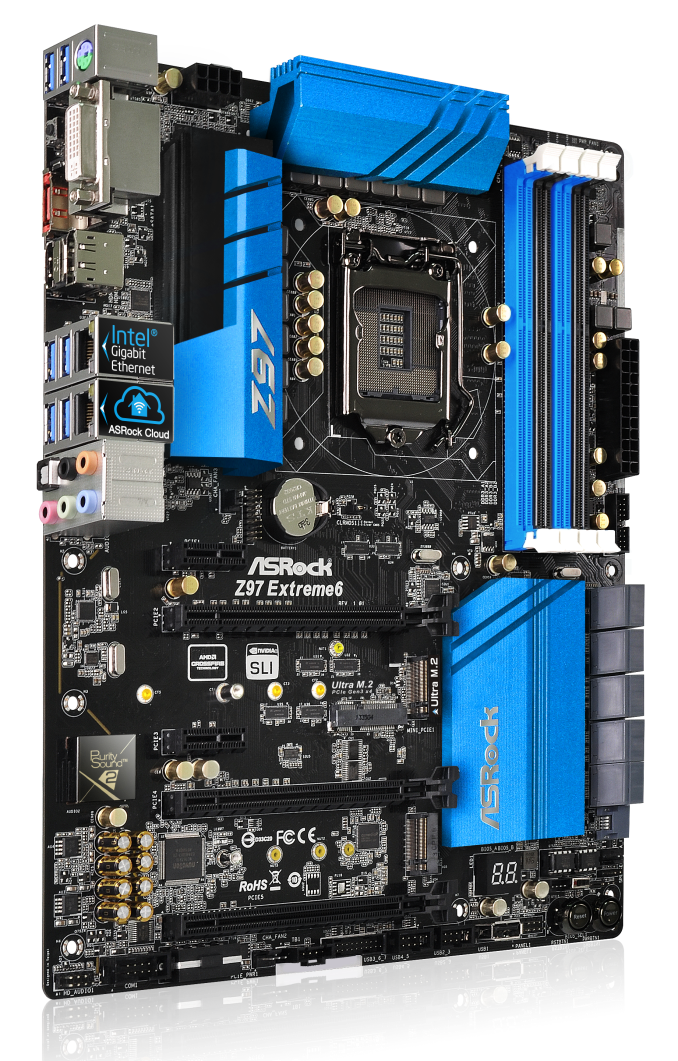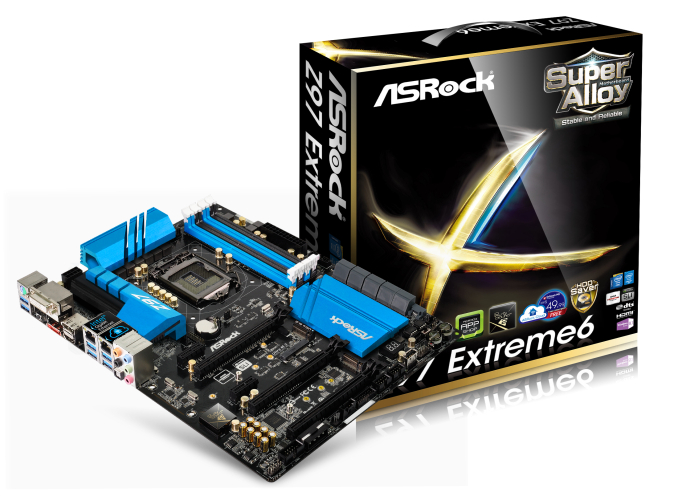ASRock Z97 Extreme6 Review: Ultra M.2 x4 Tested With XP941
by Ian Cutress on May 24, 2014 12:00 PM ESTASRock Z97 Extreme6 Conclusion
The big talking point for ASRock’s launch was the inclusion of that “Ultra M.2”, an M.2 x4 slot drawn off the CPU PCIe lanes. This is what I like to characterize as an ‘ASRock Jump’, a characteristic of ASRock to try new and different things. Some work, some do not, and others become part of the ASRock fold. I am glad that they have shown the M.2 x4 is a plausible asset to have, but unfortunately, like SATA Express, the main issue is having the hardware on the market to take advantage of it. The current M.2 drives on the market are mostly SATA based and not PCIe, and if they are to be PCIe they are most likely PCIe x2. Luckily we had an XP941 512GB, an OEM PCIe x4 SSD in to test with our review.
The two M.2 slots on the Z97 Extreme6 showed the effect of the PCIe x4 device when restricted by x2 lanes and allowed to stretch its legs with x4. With peak sequential results pointing to a +50% speed-up rather than a 3.2x that the lane bandwidth suggests, this gives SSD manufacturers more headroom to work with, and users faster drives. Although when the M.2 x4 is in use it brings the PCIe bandwidth of the first two slots down frame rates are not adversely affected at 1080p Max on our small test of a few modern titles. The major downside is that using the M.2 disables SLI, which is more a result of NVIDIA’s restriction for 8 lanes per GPU. So while the lack of drives on the market makes this almost a non-feature until later this year, it does set a very interesting precedent for other motherboard manufacturers (as well as ASRock) when they become more prevalent, or for a series of limited-GPU derived products that can siphon lanes into storage.
The specialist feature aside, the motherboard still has access to 10 SATA ports (some shared), 10 SATA USB 3.0 ports (using a controller and a hub) and enhanced Realtek ALC1150 sound. The vertical USB 2.0 port carries over from last generation and server builds, useful for verification dongles or any device that needs to be in the system permanently and away from small children at the back of the system. Next to this is a new feature called HDD Saver which, by using the cable in the box, can provide power to two SATA devices. These devices can be enabled and disabled via software in the OS, allowing users to create backups, save power or hide data from electronic attacks. The network capabilities stretch to two Ethernet ports, one Intel I218-V and one Realtek 8111GR.
The ASRock BIOS now has a Full HD mode allowing for 1920x1080 resolutions which also work on higher resolution monitors (although not by default). The color scheme of the BIOS has changed to match that of the motherboard, and in my eyes has lost some of the appeal of the last generation as the graphical icons are replaced with text. Much of the feature-set of the BIOS is the same as Z87 except for added options such as HDD Saver and My Favorites, accessible from the Main tab. The OC Tweaker tab is a single list of options that has now got too long, and ASRock should consider partitioning it up into separate menus. The software utilities now include the ASRock App Shop, an interface to download ASRock approved software and games as well as new BIOSes and drivers, and the Disk Monitor to give information about SATA devices installed.
In terms of performance, the ultra-low DPC Latency broke a new record (it has now been broken twice in two reviews) and the ASRock has plenty of automatic overclock options to keep everyone happy. Our overclocking test gave 4.6 GHz with our i7-4770K, limited by the temperature but in line with other motherboards we have tested. The initial POST time is a little long, a characteristic shared between many of the Z97 launch motherboards, however when controllers are disabled this moves down to below seven seconds.
For $170, there are going to be few motherboards that can boast 10 SATA ports and 10 USB 3.0, with access to multi-GPU configurations or an M.2 x4 slot. If we include the dual NICs and enhanced audio in that assessment, then it is plausible that one of the things missing is 802.11ac support, although users can add their own with the mini-PCIe integrated onboard. It makes me wonder why ASRock did not release a WiFi version of this motherboard. As with the other manufacturers, the biggest barrier ASRock has with the Z97 Extreme6 is that it uses storage features that have no products on the market, so users are buying into future possibilities with no guarantee which way the market will shift.
I am glad of the M.2 x4 being here, showing that it can be done and that this is the future. However it is hard to recommend a feature that cannot yet be exploited due to lack of product on the market. Given that ASRock has a history of making crazy storage options with their Extreme11 moniker, and there is no Z97 Extreme11 yet listed, I kind of want them to use a PLX chip and siphon off 16 lanes into a four M.2 x4 drive bay or something equally as ‘extreme’. I hope to see something like that (or this) at Computex. But again, we would have to await the drives to actually come to market.












43 Comments
View All Comments
jed1972 - Sunday, February 1, 2015 - link
Can i use a normal m.2 and ultra m.2 while using dual sli on my asrock z97 extreme 6?Rub9000 - Monday, June 8, 2015 - link
My biggest problem with this board is how picky it is with hard drives and video cards. I removed a drive (I have four) and wanted to use it to build a computer for my wife. I when I removed it, the motherboard freaked out and I had to format the boot drive is reinstall windows. No clue why. The 2nd thing is I use a Nvidia 660 gtx. (yes I know it is an old card). When I installed it I had to use the Gen 2 option in the bios to get the pc to boot. I contacted ASrock to help figure it out with no help from them at all. I ran into the option by chance and used it. It worked and I could log on. No thanks to ASrock support. They are awful. They even belittled my tech back ground when I posted the question on line. (I have a BSIT and over 20 years in enterprise systems support). All that said, I will not buy from ASrock again. Not a company I want to deal with in the future.xtalx - Friday, October 9, 2015 - link
I have an issue with this board as well, when trying to boot from my SSD.I have the following cards on the board:
PCIE2 - r9 280x
m.2 ultra - sm951 512MB
PCIE4 or 4 - Highpoint RAID 2720SGL
If I have the HighPoint RAID card connected, after it goes through the bios / drive checks the screen simply goes blank and the cursor flashes in the top left hand corner and Windows 7 doesn't boot. If I press any keys, such as NUM Lock the system just freezes.
If I remove the card it boots.
Tried various card alignments, but still no joy.
This card works fine in my ASROCK AMD chipset board. I've gone through the UEFI and removed all reference of the HP RAID Card from boot options, set the SATA mode to AHCI, but still no joy.
I'm hoping some one on the ASROCK forum has come across this before and has a solution.